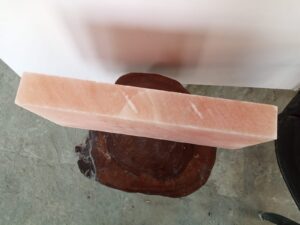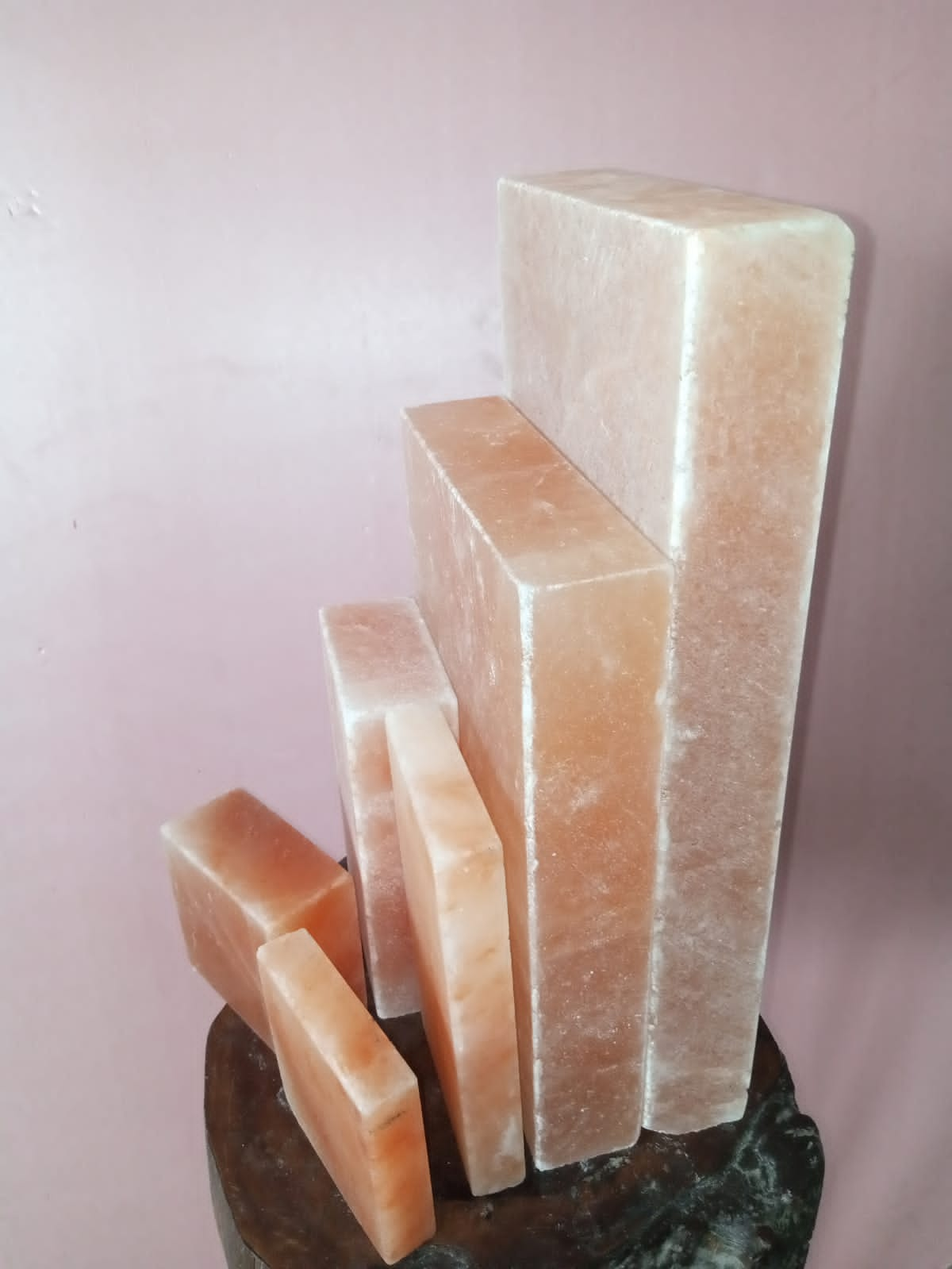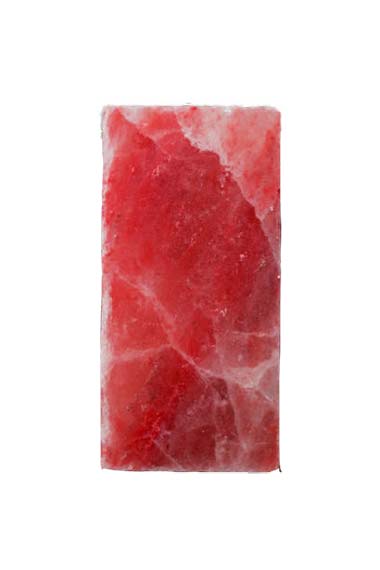If you’re referring to salt tiles and blocks , these are often made from Himalayan salt and are used for various purposes. Here are some common uses for salt tiles:
1. Cooking:
Himalayan salt tiles can be used as a cooking surface. They can be heated and used to cook or sear meat, fish, or vegetables. The salt imparts a subtle, unique flavor to the food.
2. Chilling:
Salt tiles can be chilled in the refrigerator or freezer and used as a serving platter for cold dishes such as sushi, fruits, or desserts. They can also be used to present cheeses.
3. Curing:
Some recipes involve curing or aging food on salt tiles. For example, thin slices of salmon can be cured on a salt block to create gravlax.
4. Health Benefits:
Some people believe that using Himalayan salt, known for its mineral content, in cooking or serving can provide health benefits. However, scientific evidence supporting these claims is limited.
5. Decoration:
Salt tiles and blocks can also be used as decorative elements in the kitchen or dining area. They come in various sizes and shapes and can be used as unique serving platters.
When using salt tiles, it’s important to follow care instructions provided by the manufacturer, as they can be sensitive to changes in temperature and may require specific maintenance to prevent cracking or deterioration.
Common use of Salt Tiles and Blocks
Salt tiles, often made from Himalayan salt, are versatile blocks of salt that can be used for various purposes. Here are some common uses and considerations for salt tiles:
1. Cooking Surface:
Salt tiles can be heated and used as a cooking surface for meats, fish, and vegetables. The salt imparts a unique flavor to the food, and the tiles can be used on a grill or stovetop.
2. Chilling Platter:
When refrigerated or frozen, salt tiles can be used as a serving platter for cold dishes like sushi, sashimi, fruits, or desserts. They provide a visually appealing way to present food.
3. Salt Block Grilling:
Salt blocks can be placed on a grill to cook and flavor food. This method is popular for grilling seafood, meats, and even certain fruits.
4. Curing and Aging:
Some recipes involve curing or aging food on salt tiles. For example, thin slices of salmon can be cured on a salt block to create gravlax.
5. Health and Wellness:
Himalayan salt is believed to contain various minerals, and some people use salt tiles for their potential health benefits. However, it’s essential to note that the actual health impact is a topic of debate and scientific research.
6. Cleaning and Maintenance:
Carefully follow the manufacturer’s instructions for cleaning and maintaining salt tiles. They may require special care to avoid cracking or excessive wear.
7. Decoration:
In addition to their functional uses, salt tiles can also serve as decorative elements in your kitchen or dining area.
Remember that salt tiles are sensitive to changes in temperature, and rapid temperature shifts can cause them to crack. It’s crucial to handle and care for them properly to ensure their longevity and effectiveness. Always refer to the specific instructions provided by the manufacturer for the particular type of salt tile you have.
Himalayan salt is believed to contain various minerals, and some people use salt tiles for their potential health benefits. However, it’s essential to note that the actual health impact is a topic of debate and scientific rese
The use of Himalayan salt for its potential health benefits is a topic that has generated interest and discussion. Himalayan salt is often praised for its unique composition, which includes trace minerals such as magnesium, potassium, and calcium, among others. Proponents of Himalayan salt claim various health benefits, including improved respiratory function, balanced electrolytes, and better pH balance in the body.
However, it’s crucial to approach these claims with a level of skepticism. While Himalayan salt does contain some minerals, the amounts present in typical dietary usage are relatively small. Additionally, the human body

requires minerals in specific concentrations, and getting them from a balanced diet that includes a variety of foods is generally considered more effective.
As of my last knowledge update in January 2022, scientific research on the specific health benefits of Himalayan salt, especially when used in the form of salt tiles or cooking surfaces, is limited. More research is needed to establish the actual impact of Himalayan salt on health and to what extent it can contribute to meeting the body’s mineral requirements.
Individuals with specific health conditions, such as hypertension, should exercise caution with their salt intake, even if it’s in the form of specialty salts like Himalayan salt. It’s always advisable to consult with a healthcare professional for personalized advice regarding dietary choices and health considerations.
Tiles for therapy room
Creating a therapeutic and calming environment in a therapy room involves thoughtful design and the selection of appropriate elements. When considering tiles for a therapy room, it’s important to choose materials that contribute to a peaceful atmosphere and are easy to maintain. Here are some suggestions:
1. Neutral Colors:
Choose tiles in neutral colors such as soft blues, greens, or earth tones. Neutral colors can create a calming and soothing atmosphere, which is beneficial in a therapy setting.
2. Natural Materials:
Consider tiles made from natural materials like stone, slate, or marble. These materials can add an organic and grounding element to the space.
3. Texture and Pattern:
Incorporate tiles with gentle textures or subtle patterns. Avoid overly busy designs, but a touch of texture can add depth and visual interest to the room.
4. Comfortable Flooring:
Opt for tiles that provide a comfortable and warm underfoot feel. If budget allows, consider heated flooring options for added comfort, especially in colder climates.
5. Easy Maintenance:
Choose tiles that are easy to clean and maintain. Smooth, non-porous surfaces are preferable, as they are less likely to harbor allergens or require extensive cleaning.
6. Sound Absorption:
If possible, select tiles that contribute to sound absorption. This can help create a quiet and peaceful environment, minimizing outside noise and promoting a sense of privacy.
7. Warm Colors for Comfort:
Warm colors, such as soft yellows or warm beige tones, can create a comfortable and inviting atmosphere. These colors can evoke feelings of warmth and reassurance.
8. Consider Wood-Look Tiles:
Wood-look tiles can bring a natural and calming element to the space without the maintenance concerns associated with real wood. They can also add a touch of warmth.
9. Therapeutic Elements:
Some therapy rooms incorporate features like salt tiles or water features. While these may not be traditional tile options, they can contribute to a therapeutic ambiance.
Before making any decisions, it’s advisable to consult with the therapist or professionals who will be using the space. They may have specific preferences or recommendations based on the type of therapy being conducted. Additionally, local building codes and regulations should be considered when selecting materials for any room.
Looking for salt tiles: Click here





